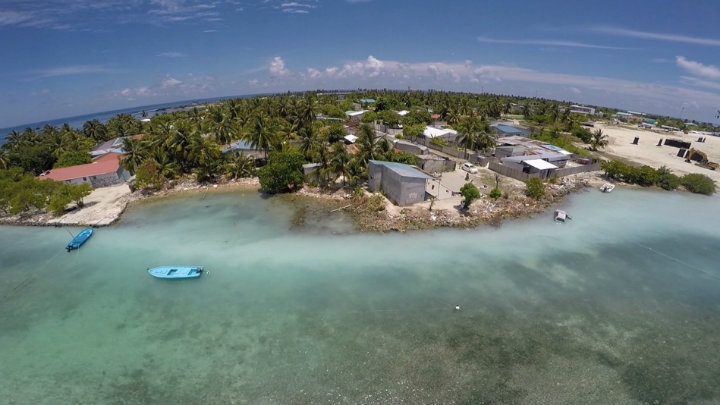This article is by Ms. Shoko Noda, the UN Resident Coordinator, UNDP Resident Representative and UNFPA Representative in Maldives.
Today, 5th June is World Environment Day, a day celebrated every year around the world to encourage awareness and action for the environment. This year’s theme, “Seven Billion Dreams. One Planet. Consume with Care”, highlights the global citizen’s responsibility towards sustainable living as a way of securing our future; one that is extremely vulnerable for the Maldives, a country often considered Ground Zero for Climate Change, due to the challenges surrounding the element of water alone.
I had only been in the Maldives for 2 months at the time when the “Malé Water Crisis” occurred in mid-December last year. An electric fire at the only water treatment plant in Malé caused an almost complete disruption to the water supply in the capital for about four days. The 133,000 residents of Malé had their first experience of what it means to be taken away the access to one of the basic necessities of life, even if for only a few hours per day. In Malé there was a feeling of panic and worry as people feared violent outbreaks if water became too scarce. Mockingly came the rain, which many believed was a blessing, but this was soon replaced with frustration as the people were ill-prepared to collect the rain water.
The experience was truly an eye-opener for myself as a newcomer to the Maldives. It highlighted how vulnerable the country is to any type of man-made or natural disasters. In stark contrast to my last post in Nepal, a mountainous land-locked country, I had a lot to learn about the true challenges facing this small island nation.
Indeed, the Maldives is increasingly becoming vulnerable to climate change and water-related disasters. More intense weather, in the form of high winds and rough seas, are increasingly causing damage and flooding throughout the country. The situation is worsened by the effects of erosion, which is reported by majority of inhabited islands. Where erosion has occurred the impact of seasonal flooding, caused by high tide, is increased dramatically. Furthermore, population pressures, coupled with the small nature of islands, mean that today many people live within 100m of the shoreline. The result is that the impact of disasters on the people of Maldives is manifold.
On the other hand, during the north-east monsoon when the dry season begins, the now familiar problem of water shortages sets in. The fragile freshwater lens in most of the islands has been contaminated either due to weak sewerage systems or salt water intrusion. The current methods of collecting rainwater in household tanks are often insufficient due to growing populations making all communities highly dependent on bottled water. In many remote islands, water-shortages are an annual occurrence.
The National Disaster Management Centre (NDMC) reports that in the past 4 years, on average 68 islands each year have requested emergency water and water has been supplied at a cost of over USD 1 million. Even though the whole nation is surrounded by water, the crisis made everyone pause for a moment to reflect on the challenges that this deceptively abundant yet precious resource can cause. The country’s vulnerability to climate change hits home where the dual challenges of flooding and prolonged dry season compound each other, a reality which exists for most islands in the Maldives.
Much is already being done for these islands to increase their resilience to natural disasters and the longer term impacts of climate change. Coastal protection in the form of seawalls, groynes, sandbags and other measures to combat erosion have almost become the norm for all islands. The country’s capacity to manage disaster risks is increasing as NDMC’s capacity grows. Community-based Disaster Risk Management Plans are a start in this regard together with the establishment of island-level Disaster Management Units and the vital Disaster Management Bill with our support.
Innovative approaches and localised solutions are also being explored through partnership between the Government and UNDP. For example, in Gaafu Dhaalu Thinadhoo a combination of hard and soft engineering measures are being used for coastal modification to address the island’s prevalent coastal problems. Similarly, longer term solutions on flood management are being demonstrated in Haa Dhaalu Kulhudhuffushi. Excess rainwater will be channelled to recharge groundwater as well as a method to combat flooding that is becoming common in many islands.
To bring an end to the problems of water shortages, Integrated Water Resource Management (IWRM) systems are being considered the most appropriate solution for the islands in the Maldives. It combines rainwater harvesting, desalination and groundwater recharge as a tripartite solution. Currently piloted in three islands in the Maldives through partnership with the Government, UNDP and UNOPS with the support of the Adaptation Fund, these solutions are already being replicated in several other islands.
In the future, these solutions can be further improved. The power hungry desalination process can use solar energy. Excess water from household roofs can be piped into the system. In combination with sewerage solutions, ground water recharge can improve the quality of the fresh water lens.
The water related challenges predicted worldwide are a reality for the Maldives already. The good news is, we have started employing innovative solutions that fit our current and future needs. The protection and sustainable use of the most important natural resource for life should be a priority for us all. On this World Environment Day UNDP renews its commitment to work hand in hand with the government and communities for sustainable use and management of water resources.
All comment pieces are the sole view of the author and do not reflect the editorial policy of Minivan News. If you would like to write an opinion piece, please send proposals to [email protected]






